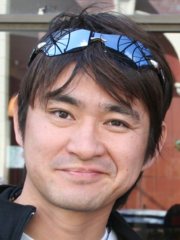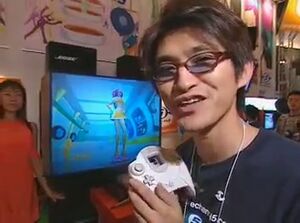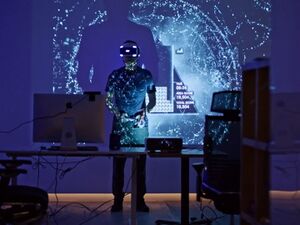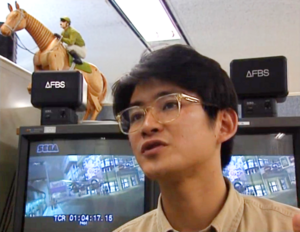Tetsuya Mizuguchi
From Sega Retro

|
| Tetsuya Mizuguchi |
|---|
| Place of birth: Sapporo, Hokkaido, Japan |
| Date of birth: 1965-05-22[1] (age 58) |
| Company(ies): Sega of Japan |
| Role(s): Producer, Executive |
| Education: Nihon University |
Tetsuya Mizuguchi (水口 哲也) is a Japanese businessman and former Sega of Japan designer, producer, and executive. One of the most well-known developers to have passed through Sega's ranks, he has been primarily responsible for several of the company's biggest arcade and console successes, including Sega Rally Championship, Manx TT Super Bike, Space Channel 5, and Rez.
Since leaving Sega in 2003, Mizuguchi has continued to lead a successful career, co-founding Q Entertainment with other former colleagues and later Enhance Inc. by himself.
Contents
Career
Early years
Tetsuya Mizuguchi was born in Sapporo, Hokkaido in 1965.[2] Studying aesthetics at Nihon University's Faculty of Arts during the 1980s out of his aim to create forward-looking media, Mizuguchi originally endeavoured to become a music video director; however, as the decade came to a close, he started to perceive the then-nascent video games as the best form for this goal, having already been formatively fascinated by Pong as an 11-year old, Xevious in college, and Xenon 2: Megablast at university.[3][4] Inspired by an encounter with the company's advanced R360 simulator during 1990, the future developer's prime choice for work in this field was Sega.[3][5][6][7] In spite of his lack of experience with the industry and a turbulent job interview with Hisashi Suzuki (in which he mistakenly cited his fondness for Namco's slogan, "We Create Play", as a reason for his application), Mizuguchi was ultimately accepted into Sega off the back of his 40-page treatment he had prepared, forecasting trends in technology, art, and entertainment.[8]
Arcade success
In keeping with his previous studies, Mizuguchi was initially given an aesthetic research role.[9][10] Taking advantage of this position, Mizuguchi convinced executives to accept attendance of a virtual reality conference in Austin, Texas - the conference fuelled his desire to utilise the burgeoning technology, already sparked by a previous interest in NASA's use of it.[11] Initially involved in tests of an unreleased AR Game Gear prototype[6] and talks with Virtuality,[3] his enthusiasm for the concept eventually saw him assigned to AM3, at that time producing pre-rendered 3DCG ride films for AM5's similarly advanced AS-1 motion simulator.[12]
His first ever project for Sega, Megalopolis: Tokyo City Battle, was among these ride films.[13] Co-directed with film maker Michael Arias,[9] the film saw Mizuguchi gain valuable experience in leading a team, as well as a taste of worldwide recognition through its inclusion in SIGGRAPH 93.[14] Throughout this time, Mizuguchi was part of a small 3DCG development department within AM3 named "Emotion Design Lab",[15] under which he instructed company newcomer Mie Kumagai to create an entrance film for Yokohama Joypolis and the 'Live UFO in Japan' event following her successful job interview with him.[16][1]
Influenced by an evening watching rally racing and his subsequent interest in the sport, Mizuguchi's next project, Sega Rally Championship, took advantage of the new Model 2 hardware's real-time 3D capabilities and established himself proper in video game development. A more visible production than Megalopolis, which was limited to select amusement facilities with the AS-1, the 1994 arcade release of Sega Rally propelled his career to new heights, leading to involvement with the similar Manx TT Super Bike after a trip to the Isle of Man.[17] With two hit arcade games now under his belt, Mizuguchi had risen in Sega's ranks, and in 1996 was granted permission to leave AM3 and lead a new division, AM Annex.[10] Further arcade racers came with follow-up titles Sega Touring Car Championship and Sega Rally 2.[18] Mizuguchi also collaborated with AM5 again for the Sega Rally Special Stage and Sega Touring Car Championship Special attractions.[7][19]
Shift to consoles

Having completed work on his final arcade project, Star Wars Trilogy Arcade, Mizuguchi was primed to become a key part of Sega's strategy in providing the Dreamcast console with innovative new concepts that could still appeal to more casual audiences.[20][21][22] Heading the new Sega Software R&D Dept. 9, he had a renewed interest in how music, sounds, and colours could play a part in video games after his participation in several European festivals and raves during the 1990s.[23] Space Channel 5 was Mizuguchi's first work borne out of this, itself a significant title in the first wave of rhythm games and highly popular among critics.[24][25]
Following its success, his division was given further prominence and renamed United Game Artists in April 2000 - as the Chief Creative Officer and president, Mizuguchi worked towards creating his most ambitious concept yet, Rez, another by-product of his continued interest in creating total sensory experiences. Selling poorly amidst Sega's termination of Dreamcast support and a simultaneous PlayStation 2 release, the game was ultimately met with universal critical approval, securing numerous awards in the subsequent months and becoming regarded as a cult classic across the world.[26][27][28]
Although consequential to their support of what was once a vital area within the company, the collapse of Sega's console business in 2001 did not deter his studio's efforts in continuing to produce innovative works. In addition to spin-offs on multiple consoles and handhelds, most notably Space Channel 5: Part 2, the Space Channel franchise notably received considerable recognition in Japan through UGA's extensive adoption of early mobile gaming technology;[2] for a time, main series character Ulala was effectively the mascot of Java applet-enabled J-Phone handsets.[29] Under the the tie-up's Ulala no Channel J content portal, all sets came pre-packaged with Tsuwa Shichouritsu, one of the most graphically advanced pieces of mobile phone software up to that point in time.[30] An estimated 8 million phones were sold with it installed.[31]
Departure from Sega

Despite the success of numerous titles, some of which headed by Mizuguchi, Sega was still in financial turmoil even after extensive restructuring and the loss of the Dreamcast. Directionless merger discussions with the likes of Namco and Sammy had eventually resulted in the latter obtaining the 22% of shares formerly held by CSK in the company,[32] ultimately becoming its largest shareholder in August 2003. Company-wide reorganization of staff began during the following month, and one of the first major changes was the dissolution of United Game Artists. All of its developers were subsequently placed in Sonic Team.
The move meant that Mizuguchi was demoted from his head position, with Sammy dictating a shift in focus from development of loss-making console titles to Sega's then-profitable arcade games. One month on from this, Mizuguchi announced his retirement from Sega whilst guesting on the October 7 edition of the Tokyo Game Lounge webcast radio programme, effective from October 10.[33] He has since retrospectively cited changes in the company's corporate culture following Sammy's buyout of shares as well as wider atmosphere shifts in the 2000s gaming industry directly influencing this departure.[34][35]
With a number of other former United Game Artists personnel following him, Mizuguchi decided to move forward by pursuing a largely independent career in the industry, allowing him a greater degree of freedom. Alongside these former colleagues, he co-founded Q Entertainment in 2004, running the company, developing numerous other music games, and experimenting with other offshoot projects. After previous hints of a collaboration with Sega and spiritual successors to the title, Mizuguchi has returned to his final large-scale product for the company by remaking Rez, first through Q Entertainment in 2008, again in 2016 under new self-founded start-up Enhance Inc, and once more the following year for PC, each in a higher definition than before. Its most recent incarnation has added virtual reality functionality; alongside his work on Tetris Effect, these have enabled Mizuguchi to finally achieve his initial VR aims formed at Sega.
Legacy
Tetsuya Mizuguchi is widely regarded as one of the most talented visionaries in video games. Mizuguchi's works, particularly the examples made at Sega, are often cited as a significant influence on numerous developers in the gaming industry. Former Codemasters producers have claimed that Sega Rally Championship was a key inspiration in the creation of the first Colin McRae Rally game;[36] similarly, Alex Rigopulos, co-founder of Harmonix Music Systems, has credited his contributions to the music game genre as one of the driving forces behind Harmonix's output.[37] Of these, Rez in particular has endured as a highly respected work among critics in spite of initial low sales; since release, it has received numerous accolades, and continues to inspire developers and designers alike.[38] In the wake of this success Mizuguchi has revisited the title for spiritual successors (Child of Eden) and remasters (Rez Infinite). He has been invited to reflect on his career at Sega for conferences and documentaries by the likes of Academy of Interactive Arts & Sciences and CNA.
Quotes
| “ | Games are a very unique medium. They exist beyond language, beyond culture, and people are fascinated by games. I don't know how long I will live, but I want to learn more about games — and there is more to learn about creating better games. | „ |
— Tetsuya Mizuguchi on his departure from Sega of Japan | ||
Production history
Games
- Megalopolis: Tokyo City Battle (AS-1; 1994) — Line Producer/Story
- Sega Rally Championship (Model 2; 1995) — Produced by
- Manx TT Super Bike (Model 2; 1995) — Producer
- Sega Rally Championship (Saturn; 1995) — Produced by
- Sega Rally Championship (Saturn; 1995) — Written by
- Sega Touring Car Championship (Model 2; 1996) — Produced by
- Sega Rally Championship Plus (Saturn; 1996) — Produced by
- Sega Rally Championship (Windows PC; 1997) — Produced by
- Sonic Jam (Saturn; 1997) — Special Thanks[39]
- Sega Touring Car Championship (Saturn; 1997) — Executive Producers
- Sega Rally 2 (Model 3; 1998) — Produced by
- Sega Touring Car Championship (Windows PC; 1998) — Executive Producers
- Star Wars Trilogy Arcade (Model 3; 1998) — Project Organizer
- Sega Rally 2 (Dreamcast; 1999) — Producer
- Space Channel 5 (Dreamcast; 1999) — Producer
- D-2 (Dreamcast; 1999) — The Producer Wishs To Thanks
- Shenmue (Dreamcast; 1999) — Main Scenario
- Roommania 203 (Dreamcast; 2000) — 声の出演 (as 水口 哲也)
- US Shenmue (Dreamcast; 2001) — Main Scenario
- Rez (Dreamcast; 2001) — Producer
- Space Channel 5: Part 2 (Dreamcast; 2002) — Producer
- Space Channel 5: Part 2 (PlayStation 2; 2002) — Producer
- Space Channel 5 (PlayStation 2; 2002) — Producer
- Space Channel 5: Ulala's Cosmic Attack (Game Boy Advance; 2003) — Special Thanks
- Space Channel 5: Special Edition (PlayStation 2; 2003) — Producer
- Sega Rally Championship (PlayStation 2; 2006) — Produced by
- Rez HD (Xbox 360; 2008) — Producer
- Space Channel 5 VR Kinda Funky News Flash! (PlayStation 4; 2020) — Very Special Thanks to
- Iri-san (Dreamcast; unreleased) — Producer
Videos
- Sega Amusement CG World Best Collection (LaserDisc; 1995) — Producer
- CGMV Sega Rally Championship 1995 (VHS; 1995) — Produced by
- CGMV Sega Rally Championship 1995 (VHS; 1995) — Technical Driver
Music
- Sega Rally Championship Ignition (CD; 1995) — "My dear friend, Rally" Written by
- Sega Touring Car Championship (CD; 1997) — Producer[40]
- Space Channel 5 Original Soundtrack (CD; 2000) — Producer[41]
- Mexican Flyer Remix Tracks Inspired by Space Channel 5 (CD; 2000) — Producer[42]
- Space Channel 5 Part 2 Soundtrack Volume "Chu!!" (CD; 2002) — Game Producer
- Space Channel 5 Part 2 Soundtrack Volume "Hey!!" (CD; 2002) — Game Producer
- Sega Rally Championship Ignition (CD) (1995)
- Sonic Jam (1997) — Special Thanks
Song credits
Sega Rally Championship Ignition
- My Dear Friend, Rally — Lyrics (with Kenneth Ibrahim)
Magazine articles
- Main article: Tetsuya Mizuguchi/Magazine articles.
Photographs
- Main article: Photos of Tetsuya Mizuguchi
External links
- In the Realm of the Senses: Tetsuya Mizuguchi’s Synthesis of Synaesthesia & Video Gaming - Part I: The Birth of an Interactive Artist article by Amir Moosavi at Medium
- In the Realm of the Senses: Tetsuya Mizuguchi’s Synthesis of Synaesthesia & Video Gaming - Part II: The Long and Winding Road article by Amir Moosavi at Medium
- In the Realm of the Senses: Tetsuya Mizuguchi’s Synthesis of Synaesthesia & Video Gaming - Part III: "Hey there, space cats..." article by Amir Moosavi at Medium
- Tetsuya Mizuguchi: A Child of Technology article by Stephen Lambrechts at IGN
- Tetsuya Mizuguchi Speaks About the Soul of Space Channel 5 article by Anoop Gantayat at IGN
- IGNDC Sits Down with Space Channel 5's Tetsuya Mizuguchi article by Brandon "Mad Morolien" Justice and Colin "Phat Beats" Williamson at IGN DC (Wayback Machine)
- Sega's Tetsuya Mizuguchi Interviewed article at GameSpot
- Mizuguchi headlines TIGRAF fest in Tokyo article by Hirohiko Niizumi at GameSpot
- The Making Of: Sega Rally Championship 1995 article at Edge Online (Wayback Machine)
- 2016 Reddit AmA at Reddit (Wayback Machine)
- Otaku interview at YouTube
- 1999 Space Channel 5 promotion at YouTube
- 2021 CNA Insider documentary featuring Mizuguchi at YouTube
- Tetsuya Mizuguchi at Death Valley development footage at YouTube
References
- ↑ 1.0 1.1 File:PS2PressInformation 2001-09 Rez Profile of Head of UGA.pdf
- ↑ 2.0 2.1 http://www.sega.com/segascream/developers/post_amprofiles.jhtml?article=dev_am9_uga (Wayback Machine: 2002-07-05 17:50)
- ↑ 3.0 3.1 3.2 http://www.kotaku.co.uk/2016/05/27/tetsuya-mizuguchis-memories-from-segas-golden-age (Wayback Machine: 2019-02-02 21:27)
- ↑ https://www.polygon.com/2016/3/17/11256396/rez-gdc-post-mortem-tetsuya-mizuguchi (Wayback Machine: 2016-03-21 06:27)
- ↑ https://www.reddit.com/r/IAmA/comments/50eatm/i_am_video_game_designer_tetsuya_mizuguchi_ama/d73hb8i/ (Wayback Machine: 2021-11-28 01:12)
- ↑ 6.0 6.1 https://www.sohu.com/a/346574511_395737 (Wayback Machine: 2021-11-28 01:36)
- ↑ 7.0 7.1 https://www.gamedeveloper.com/pc/dice-mizuguchi-talks-artistry-and-commerce-in-concert (Wayback Machine: 2021-08-27 09:47)
- ↑ https://www.google.co.uk/books/edition/The_Sega_Arcade_Revolution/7qZhDwAAQBAJ?hl=en&gbpv=1&pg=PA160&printsec=frontcover
- ↑ 9.0 9.1 https://news.denfaminicogamer.jp/english/170612/2 (Wayback Machine: 2021-06-05 08:15)
- ↑ 10.0 10.1 Next Generation, "November 1996" (US; 1996-10-22), page 83
- ↑ https://www.newstatesman.com/culture/games/2017/07/how-tetsuya-mizuguchi-reinvented-video-games-his-love-synaesthesia (Wayback Machine: 2020-03-26 08:52)
- ↑ Beep! MegaDrive, "October 1994" (JP; 1994-09-08), page 96
- ↑ Beep! MegaDrive, "November 1993" (JP; 1993-10-08), page 106
- ↑ https://ghostarchive.org/varchive/JEfD9TcoHUU
- ↑ Beep! MegaDrive, "October 1994" (JP; 1994-09-08), page 95
- ↑ https://www.redbull.com/jp-ja/game-producer-mie-kumagai (Wayback Machine: 2021-07-11 20:12)
- ↑ https://www.engadget.com/2006-11-08-migs06-tetsuya-mizuguchis-keynote-liveblogged-sorta.html (Wayback Machine: 2021-11-07 18:56)
- ↑ Next Generation, "February 1998" (US; 1998-01-20), page 79
- ↑ Next Generation, "February 1998" (US; 1998-01-20), page 80
- ↑ http://archive.videogamesdaily.com/features/tetsuya_mizuguchi_iv_oct05_p1.asp (Wayback Machine: 2011-07-17 20:27)
- ↑ http://www.gamasutra.com/view/feature/2310/e3_report_the_path_to_creating_.php (Wayback Machine: 2016-04-19 11:38)
- ↑ https://www.polygon.com/2016/11/22/13700394/rez-retrospective-tetsuya-mizuguchi-iam8bit-book-rez-infinite (Wayback Machine: 2016-11-23 12:07)
- ↑ https://www.eurogamer.net/articles/2015-02-08-in-media-rez-the-return-of-tetsuya-mizuguchi (Wayback Machine: 2018-06-12 23:52)
- ↑ Computer & Video Games, "August 2000" (UK; 2000-07-12), page 114
- ↑ Famitsu, "1999-12-24" (JP; 1999-12-10), page 31
- ↑ http://sega.jp/corp/release/2002/1219/ (Wayback Machine: 2007-11-18 20:38)
- ↑ http://www.interactive.org/games/video_game_details.asp?idAward=2003&idGame=446 (Wayback Machine: 2018-02-06 19:51)
- ↑ @yumikomiyabe on Twitter (Wayback Machine: 2021-11-29 01:38)
- ↑ http://www.u-ga.com/press/released/release_010514.htm (Wayback Machine: 2001-06-07 06:47)
- ↑ http://www.1up.com/features/tetsuya-mizuguchi-instincts (Wayback Machine: 2013-03-02 10:57)
- ↑ http://www.gamespot.com/news/2004/05/18/news_6098677.html (Wayback Machine: 2008-10-06 13:28)
- ↑ https://www.gamespot.com/articles/tetsuya-mizuguchi-to-exit-sega/1100-6076535/ (Wayback Machine: 2018-04-01 00:35)
- ↑ http://games.kikizo.com/features/tetsuya_mizuguchi_iv_oct05_p1.asp (Wayback Machine: 2005-12-27 04:54)
- ↑ https://ghostarchive.org/varchive/DwBoLPEhljQ
- ↑ http://www.edge-online.com/features/making-colin-mcrae-rally/ (Wayback Machine: 2013-10-12 07:54)
- ↑ https://ghostarchive.org/archive/7Rwew
- ↑ https://www.gamesindustry.biz/articles/2019-01-15-rez-and-the-power-of-owning-your-own-experience (Wayback Machine: 2019-01-15 17:48)
- ↑ File:Sonic Jam Saturn credits.pdf
- ↑ File:STCC CD JP Booklet.pdf, page 8
- ↑ File:SC5OST CD JP card5.pdf, page 2
- ↑ File:MFRTISBSC5 CD JP Box Back.jpg
